
14. The Schleswig-Holstein Plebiscite
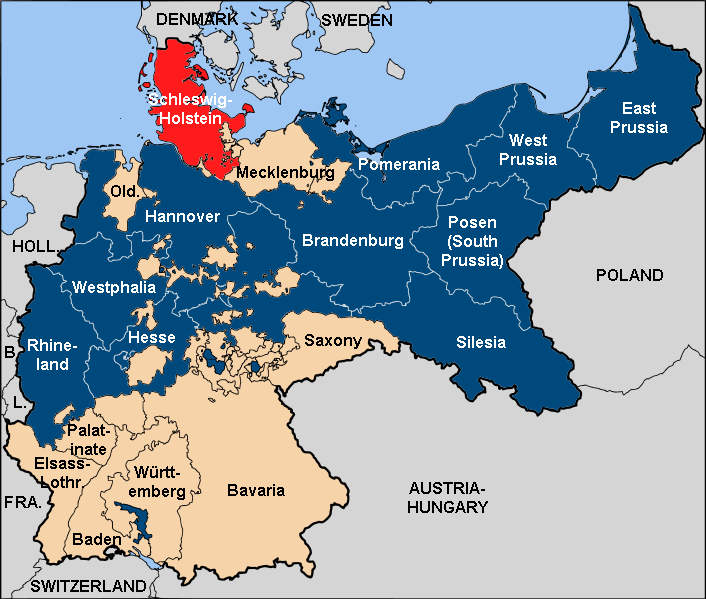 SCHLESWIG-HOLSTEIN - Prussia's Northern Province
SCHLESWIG-HOLSTEIN - Prussia's Northern Province
For many years I maintained the position that the only fair plebiscites that had taken place in Germany after the fall of the German Empire in 1918 following the First World War were those of East Prussia (Ostpreußen) and Schleswig-Holstein (1920). The East Prussian plesbiscite was an overwhelming vote for Germany and a decisive rejection of Polish ethnic claims. So, I assumed, had the Schleswig Plebiscite been, though I had never researched it (until now). I assumed that the Allied Commission, consisting of representatives from Great Britain, France, Norway and Sweden, would ensure fair play in spite of the bias of the French against the German population of Upper Silesia (Oberschlesien) and the fact that Denmark was not a belligerent in the war. After my study I was to be disappointed and dissilusioned once again.
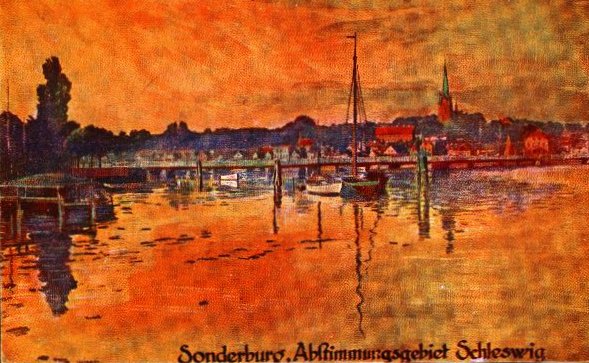 SONDERBURG - 44% of the population voted for Germany, 56% for Denmark
SONDERBURG - 44% of the population voted for Germany, 56% for Denmark
The plebiscite was rigged from the beginning - not at the voting booths - but in the way the voting system had been set up. Instead of simply letting each parish or kreis decide whether they wanted to be in Germany or Denmark, and then creating a fair boundary between the German and Danish regions, the Province of Schleswig was arbitrarily divided up by the Danes into two Zones - Zone 1 (in the north with a clear Danish majority but with substantial German areas) and Zone 2 (in the south with a clear German majority and no Danish majority areas). Each zone then had to make its mind up in a separate vote which state it wanted to belong to:
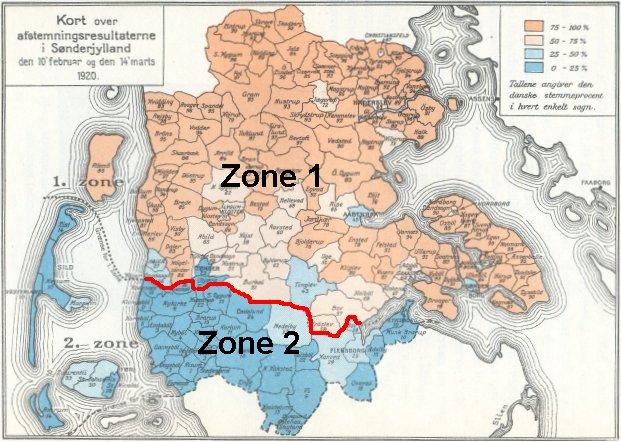
As can be seen from the map (above - taken from the Danish book by Peter Lisløe, Nordens Historie - Glyndendal, Copenhagen, 1960) large numbers of kreise had either had a German majority or were roughly split 50:50 between Germans and Danes. And though a clean line clearly could not have been drawn resulting in all German-majority kreise reverting back to Germany and all Danish-majority kreise being handed over to Denmark, a fair balancing could have been done to ensure a reasonably clean ethnic border, with kreise in the 60:40 being roughly equally divided up. The border that was pre-chosen (dividing the two plebiscite zones) basicaly ensured that Denmark got the best cut of the pie, including Tondern (Tønder) which had an overwhelming 77% majority of Germans and Usbjærg which had an even larger 83% majority. Since these two kreise were on the Zone Border they could easily have been transferred to Germany without any problems. The same was true of Landsogn and Højer which had German majorities of 62% and 73%, respectively. A fairer and more equal division would have seen the border something like the one I have drawn below:
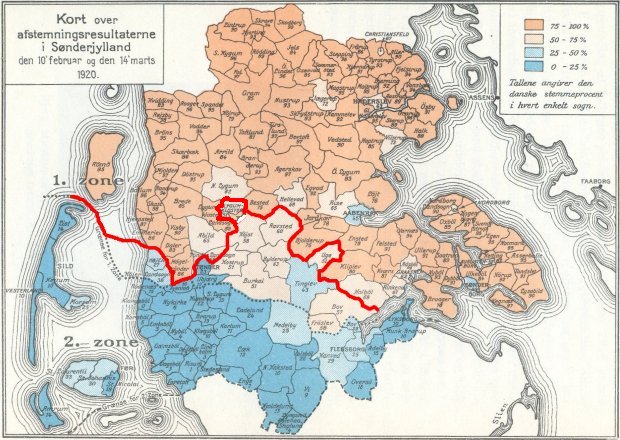
The argument is sometimes made that the border finally chosen was just and fair because of German colonisation of Schleswig since 1864 when Schleswig was awarded to Prussia by the Treaty of Vienna following the Danish War of the same year. Austria (Österreich) administered Holstein from 1864 to 1866 after which the province was acquired by Prussia and joined to Schleswig, creating the Prussian Province of Schleswig-Holstein. However, it must be realised that Schleswig-Holstein, along with Hamburg, with their overwhelming German majority, had been Danish colonies for centuries and had resulted in a large influx of Danish colonists into German-speaking areas. Denmark's colonial involvement with German lands ended with the Danish War of 1864. A few years later the whole of Germany would be unified in 1870.
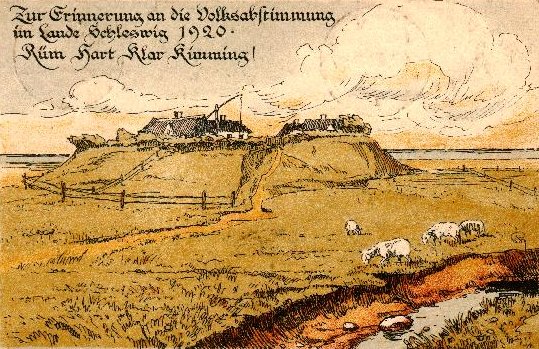
The basis of the Schleswig Plebiscite was, however, different from those held in East Prussia and Silesia. The Treaty of Vienna had contained a provision for a popular plebiscite to be held in Schleswig (Slesvig in Danish) which was never held. Therefore 'officially' the Allies were not seeking to reward Denmark which had been neutral in World War 1) but to make good the promise made by Prussia and Austria some 55 years before. Therefore, unlike the other plebiscites, this was conducted in accordance with International Law. The issue was never, therefore, the plebiscite per se but the unfair manner in which it was handled, clearly being heavily weighted in Dennmark's favour. Therefore there is a case to be made for the claim that this plebiscite was so engineered, as had the Upper Silesian one, to 'punish' Germany.
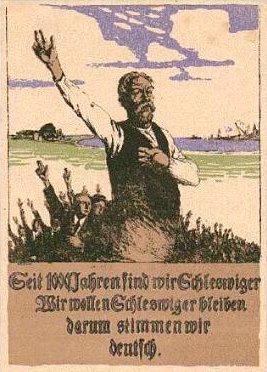 "For a Thousand Years We Have Been Schleswigers
"For a Thousand Years We Have Been Schleswigers
We Want to Remain Schleswigers
Therefore We Vote German"
Finally, had a plebiscite been taken for the whole of Schleswig as a single unit, which it had been for centuries, there is no doubt that the whole Province would have been returned to Germany. It's artificial division into two zones ensured that this did not happen. Why did this happen? Why wasn't Upper Silesia likewise divided into two zones? In the event, Upper Silesia voted 60:40 in favour of Germany which should have settled the matter. Instead, Polish terrorist action ensured that Upper Silesia, at the insistence of the French (but opposed by the Italian section of the Plebiscite Commission) was partitioned into two zones to deliberately ensure that Poland got the lion's share of the industrialised coal region for no other reason than to 'punish' Germany (even though Poles fought on both sides).
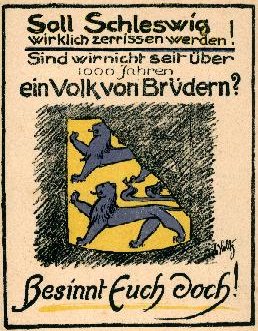 "Must Schleswig Really Be Broken Up?...
"Must Schleswig Really Be Broken Up?...
For a Thousand Years One People, One Brotherhood"
No such issue existed in Schleswig, which was principally farming land and fishing villages on the coast. The final border between Germany and Denmark, as also between Germany and Poland, was not, therefore, an ethnic one based on the self-determination of peoples as American President Woodrow Wilson had insisted, but on the basis of politics. The plebiscites simply provided a political veneer of legitimacy. Even the postage stamps for the Plebiscite Areas, printed only in Danish, show the result that was 'expected':
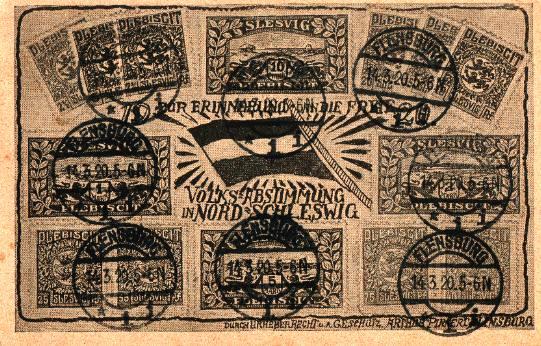
Once the two zones had been announced, the Germans on the north side knew what to expect as this poster shows:
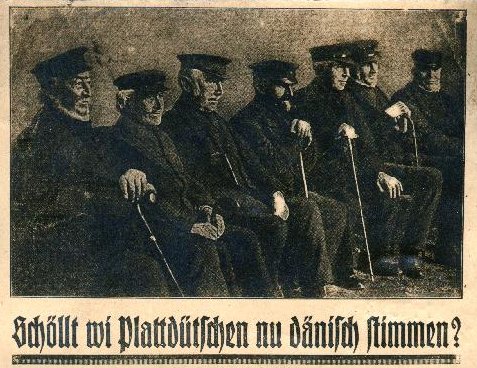 "Must We Germans Vote Danish Now?"
"Must We Germans Vote Danish Now?"
Clearly, then, the plebiscite in Schleswig was not fair. It was rigged from the beginning at the insistence of the Danish politicians.
After the conquest of Denmark by Germany in 1940 no attempt was made by the occupier to readjust the border. This was not because Germany regarded the border to be just but to politically woo Denmark onto the Axis side. This certainly paid off following the defeat of Nazi Germany for there were no explusions, exterminations or 'ethnic cleansing' of the German population (as in Poland and Czechoslovakia) nor attempts to force the Germans to change their culture and language (as in Elsaß-Lothringen). In consequence the relationship between Germans and Danes on both sides of the 1920 border have been good unlike in the east and west.
No, the plebiscite in Schleswig was not fair but at least there has been a peaceful outcome and no ethnic strife today.
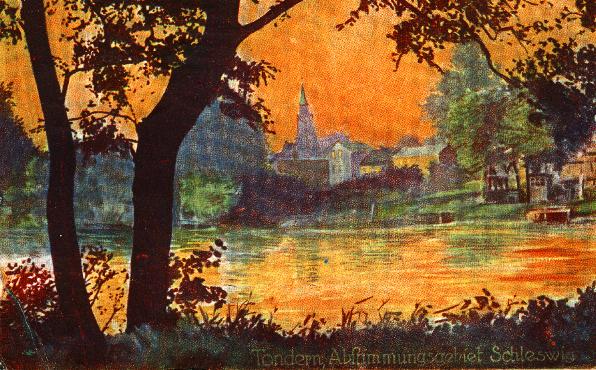 TONDERN - A German City Given to Denmark in the Plebiscite
TONDERN - A German City Given to Denmark in the Plebiscite
Created 17.11.2010 | 17.11.2010
Copyright © 2010 SBSK Preussens Gloria
Alle Recht vorbehalten - All Rights Reserved


